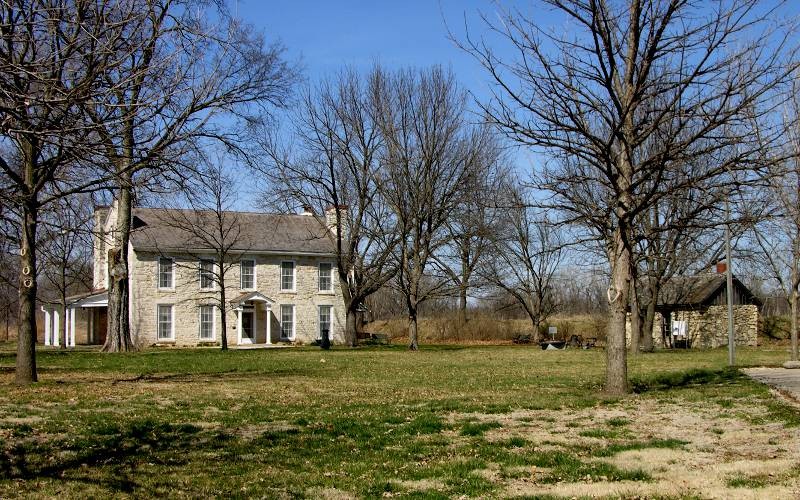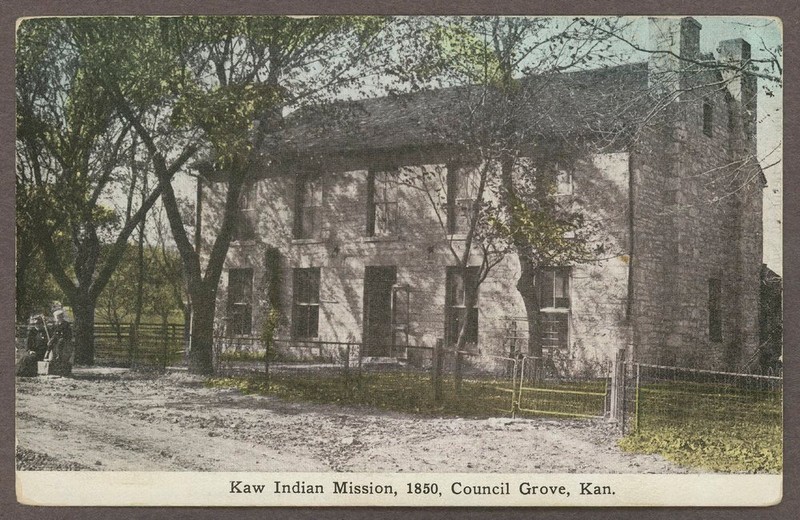Kaw Mission
Introduction
Text-to-speech Audio
As part of a broader policy of allotment and assimilation, the U.S. Government first limited the Kanza (Kansa) people of Kaw Nation to twenty square miles of property (Kaw Reservation) in and near Council Grove. The Methodist Episcopal Church South also worked with the government to operate a mission school, fully funded by the government, which opened in 1851. The Kaw people had no desire to send their children to the school, other than orphans and other dependent children. The lack of participation forced the government to withdraw its support by 1854, but a part of the school meant for White children remained open. The Kanza people, for whom Kansas is named, eventually saw their reservation decline in size before the government forced them to move to Oklahoma. Despite their attempts to maintain their culture and way of life, the last full-blooded member of Kaw nation died in the year 2000.
Images
The Kaw Mission in Council Grove. The smaller building is one of more than 138 homes built for the Kaw by the government, but the Kaw had no desire to live in "American style" homes.

1850 photo of the Kaw Mission in Council Grove from the Kansas Historical Society

Kaw Mission and Museum
.jpg)
Backstory and Context
Text-to-speech Audio
In 1850 the Methodist Episcopal Church South signed a contract with the government to establish a mission and school for the Kaw Indans (Kanza Indians) at Council Grove. When completed in 1851, the school included a large schoolroom for the Kaw people and a small room for White children. Regarding the education of Native Americans, the school existed as part of a broader movement in the U.S. of attempting to displace Native Americans physically or "Americanize" them (or civilize them) by assimilating Native American youth into Euro-American culture. A lack of participation and rising costs forced the government to withdraw its support in 1854, meaning the mission closed its doors to the Kaw people, but the school continued to serve White children. The Kaw eventually got displaced again to modern-day Oklahoma. The state name of Kansas is all the remains of the Kanza people, as the last full-blooded member of the Kaw nation died in the year 2000.
An 1846 treaty with the Kanza (or Kansa or Kaw Indians) relegated them to a diminished reservation measuring twenty square miles, which included the site of present Council Grove. The Methodist Episcopal Church South, which had served as missions to Kaw Nation since 1830, sought to build a mission and school for the Kaw people. In addition to math and reading skills, the school provided a distinct Euro-American style of education that could help Native Americans assimilate into American society. The government-funded building, completed in 1851, could house up to fifty students plus teachers and mission workers. However, the Kaw people showed little interest in the mission; thus, they kept most of their children away from the school. Average attendance amounted to thirty students per year, primarily orphans and dependant boys. The lack of interest shown by the Kaw Nation coupled with the high cost of the mission resulted in the school closing only three years after it opened, finally closing its doors to Native Americans in 1854.
The bounds of the Kaw reservation grew smaller in 1859, reduced to a 9- by 14-mile tract. And then, in the 1870s, the government forced the Kaw people to move to the Indian Territory or modern-day Oklahoma. The constant decrease in land and movement resulted in an ever-declining Kansa Nation population. The last full-blood Kanza, William A. Mehojah, died in 2000.
The school also included room for up to fifteen white children when it opened in 1851, one of the first schools for White children in the Kansas Territory. The school for Whites remained open after 1854 despite the government funding coming to an end. The Huffaker family purchased the building in 1865 and maintained ownership of the building for more than eighty-five years. In 1951, the Kansas Legislature approved the purchase of the mission property; the Kansas Historical Society managed the historic mission building.
Today, the building functions as a museum that offers visitors insight into the Santa Fe Trail, the school, and the Kaw people. An additional feature at the museum involves a small, stone "Indian Hut" adjacent to the mission building. The hut appeared much more like a small cottage or home, typical of homes built by Americans. It is one of 138 of these structures the federal government constructed on the diminished Kaw Reservation in 1861 as intended residences for the Kaws. However, generations of Kanza people lived happily in animal-skin tepees and bark-and-mat lodges. Hence, they wanted nothing to do with their new federally-built homes. Instead, they stabled their horses and dogs in them. It speaks to the Kaw's lack of interest in taking part in what the federal or state governments offered them, including the school. They showed little interest in being "Americanized" or "civilized," as White Americans deemed it. Nevertheless, efforts to save their culture failed so that by the year 2000, the Kanza people, for whom the state of Kansas is named, ceased to exist.
Sources
McNally, Michael D. "Coda: Naming the Legacy of Native Christian Missionary Encounters" In Native Americans, Christianity, and the Reshaping of the American Religious Landscape, edited by Martin, Joel W. and Mark A. Nicholas. 289-304. University of North Carolina Press, 2010. Accessed July 21, 2021. doi:10.5149/9780807899663_martin.17.
Hutchinson, Elizabeth. "Modern Native American Art: Angel DeCora's Transcultural Aesthetics." The Art Bulletin New York. 83, no. 4 (2001): 740–56.
Pankratz, Richard D. "Nomination Form: Old Kaw Mission." National Register of Historic Places." nps.gov. 1971. https://npgallery.nps.gov/GetAsset/10af1426-d08f-4cd6-8c26-b4cd94f93290/.
Kansas Travel. http://kansastravel.org/kawmission.htm
Kansas Historical Society. https://www.kansasmemory.org/item/228850
By Douglas Kulp - City between the Ages, CC BY 2.0, https://commons.wikimedia.org/w/index.php?curid=36303160
